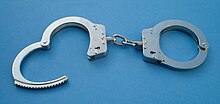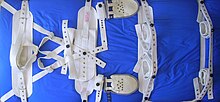Physical restraint
Physical restraint refers to means of purposely limiting or obstructing the freedom of a person's or an animal's bodily movement.[citation needed] Alternatively different kinds of arm locks deriving from unarmed combat methods or martial arts are used to restrain a person, which are predominantly used by trained police or correctional officers.[5] Vast numbers of care staff are trained in 'physical interventions' including physical restraint, although they rarely employ them in practice.According to a survey conducted on 689 patients in 11 psychiatric hospitals in Japan, the average time spent in physical restraints is 96 days.As a result, the Japanese Ministry of Health, Labour and Welfare has revised its guidelines for elderly people in nursing homes to have more restrictions against body restraints.YoungMinds and Agenda claim restraints are "frightening and humiliating" and "re-traumatises" patients especially women and girls who have previously been victims of physical and/or sexual abuse.According to the letter over half of women with psychiatric problems have suffered abuse, restraint can cause physical harm, can frighten and humiliate the victim."Mental health units are meant to be caring, therapeutic environments, for people feeling at their most vulnerable, not places where physical force is routine".






Handcuffschainswrought ironlegcuffspadlockGermanyHiatt speedcuffsstrapsstraitjacketsunarmed combatmartial artspolicecorrectional officersprisonbelly chainsprisonersBritish PoliceofficersAssociation of Chief Police Officersduty beltpolice vanscorporal punishmentflagellationteachersteaching assistantsautismTourette syndromede-escalationIndividuals with Disabilities Education Actescapologistsillusionistsstunt performersmedical restraintspsychiatric hospitalsPhilippe PinelJean-Baptiste Pussinkidnapperduct tapeeroticismfalse arrestfalse imprisonmentspecial educationpostural asphyxiastrangulationchokingvomitinghypothermiahyperthermiadeep vein thrombosispulmonary embolismGaggingasphyxiaMedical restraintMinistry of Health, Labour and WelfareKelly SavageelectroniccharterRethink Mental IllnessJeremy HuntBadge of shameBarefootbelly chain (restraint)DetentionJudicial corporal punishmentPain compliancePin-down scandalPrison uniformPrisonerPrisoner abusePublic humiliationRestraint chairStrapping (punishment)KidderminsterJohn Wiley & Sons, Inc.
